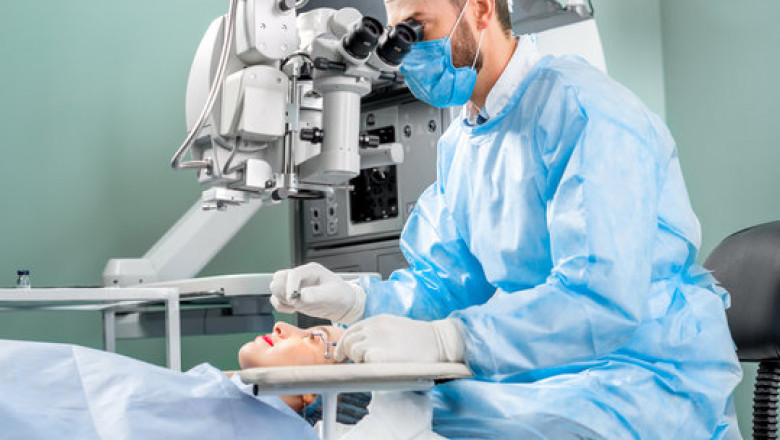views
Phacoemulsification Machines
Phacoemulsification is the most common technique used for cataract surgery today. It involves using an ultrasonic handpiece and tip to emulsify and remove the lens. Phacoemulsification machines are a key device used in these procedures.
Modern phacoemulsification machines are highly computerized systems that provide precise control and monitoring of key functions. The machine functions to carefully emulsify the cloudy lens using ultrasonic energy and then carefully aspirate the tiny lens fragments. Top-of-the-line machines allow surgeons to customize settings for ultrasonic power, flow rates, vacuum levels and other parameters. This helps ensure a smooth and safe procedure.
The Cataract Surgery Devices is also crucial for automated functions like detecting when fragmentation is complete and automatically stopping ultrasound when enough lens material is removed. On-screen monitors help surgeons view the surgery in progress and closely track key parameters. Advanced machines with integrated digital technologies also allow recording surgical videos and capturing images during procedures.
I/A Systems
I/A or irrigation and aspiration systems are another important device type used alongside phacoemulsification machines. These function to irrigate the eye with balanced salt solution and aspirate emulsified lens fragments and fluids out of the eye.
Top-quality I/A systems provide precise control over independent functions of irrigation and aspiration. Certain advanced digital systems even allow custom pre-programmed settings for different surgical steps like manual cortical cleanup. High flow rate capabilities ensure rapid removal of debris without surge or fluctuations. Built-in sensors and alarms help identify issues like blockages.
Integrated digital pedal controls on machine footpanels provide ergonomic switching between phaco, irrigation and aspiration functions. This streamlines the workflow. Multifunction reusable tips are designed for maximum flow and efficiency. Disposable sleeve tips are also available in standard and pre-folded designs. Advanced I/A technologies help achieve high-quality results through optimized fluidics management.
Phacoemulsification Tips and Sleeves
The phacoemulsification tips and sleeves that interface directly with eye tissue are another critical component. Their design impacts key factors like ultrasound transmission, fragment removal and tissue protection.
Top manufacturers offer a variety of tip designs evaluated for performance metrics likefragmentation efficiency and heat generation. Popular options include flared, pear-shaped and glide tips.Advanced materialssuch as titaniumprovide increased durability.
Single-use sleeves protect both eye and tip from contact.Advanced sleeve typesintegrate irrigation channels oremploy extra-thinwall designswithproprietarycoatingsto optimizeflow while staying ultra-smooth.Some come pre-folded for easier insertion.
Selecting high-quality, precision-engineered tips and sleeves adapted for surgeon technique and case complexity helps optimizesafety and efficiency. Manufacturers also provide autoclavable "hub" systems for reusable components like metal tips.
Viscodissection Devices
Viscodissection or “ Spread and Scissor ” techniques utilize viscoelastic solutions and specialized devices to safelycreate spaces and dissect tissue planes during surgery.
Viscoelastic injection/aspiration tips, cannulas and spreaders gently mobilize tissue and maintain space created by fluid mechanics. Blunt spreaders (often Made of surgical Stainless Steel or Plastics) separate tissue layers like lens capsule from zonules. Their tapered, rounded design glides between delicate structures to protect them.
Advanced spreadersintegrate irrigationchannels to maintain a bubble of fluid. Some have precision tips or offset jawsfor subtle angled maneuvers. Disposable, pre-connected devices integratespreader,cannula and syringe for one-handed operation.
Proper viscodissection techniques aided by quality devices helps surgeons delicately manipulate tissuespaces intraoperatively in a protected, hydratedenvironmentfor improvedsafety and outcomes.
Capsular Polishes and Protections
Posterior capsular opacification or “ PCO ” is a possible complication that new lens implant technologies and surgical techniques continue working to reduce. Intraoperative devices help supplement other prevention strategies.
Capsular polishing devices usedelicate nylonfiber or polymer-coated metal rings sutured to instruments to carefully polish lens capsule edges and epiphonema left behind after phacoemulsification. This aims to minimize remaining cells that could lead to PCO.
Capsular tension/protective rings are also used to protect thecapsule and maintain its naturalshape/spaces until lens implants are placed.Made of PMMA or hydrogel, they gentlysupport capsule integrity.Certain designs have sharp edges minimizeremaining opacity-causing cells.
Adjunct lenses:In select cases,surgeons maychoose to implanta secondaryIOL tosupplement the natural or primary implanted lens.These adjunct lenses come in varioussizes and powers to fine-tunesurgical results.
Quality devices innovated by manufacturers aim to give surgeons improved tools and techniques for capsule protection and complication mitigation in cataract surgery.
Get this Report in Japanese Language:
Get this Report in Korean Language:
About Author:
Money Singh is a seasoned content writer with over four years of experience in the market research sector. Her expertise spans various industries, including food and beverages, biotechnology, chemical and materials, defense and aerospace, consumer goods, etc. (https://www.linkedin.com/in/money-singh-590844163)

















![[1 (888) 326-1024] How to Get in Touch with Expedia 24/7 Support Team: Phone, Email, and Chat Options](https://timessquarereporter.com/upload/media/posts/2025-06/01/1-888-326-1024-how-to-get-in-touch-with-expedia-24-7-support-team-phone-email-and-chat-options_1748757002-s.jpg)




Comments
0 comment